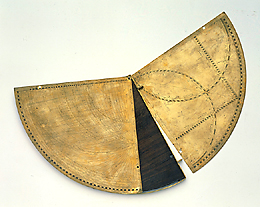
 |
| Catalogue |
 |
 Quadrant Quadrant I, side 1: The limb is engraved with a doubled zodiacal calendar (with 0? Aries at 10.5 March) reading respectively to 1? and 1 day by scales with alternated hatched and unhatched divisions. The two outer arcs read from the apex, the two inner from the limb. Above the upper arc (reading towards the apex) is a scale of 90?, and above this the names of seventeen festivals are marked although sometimes at some distance from the arc so as to avoid confusion with the lines and numbers of the horary diagram drawn above by right-curving arc towards the centre of the instrument at the apex. The festivals named are written sometimes in the direction of the limb, sometimes in the direction of the apex of the instrument, presumably so that they may be readily associated with the appropriate half year when their dates are read off. The festivals are, Winter half year: 'Na{tus} D{omi}ni', 'Epiph{an}ia Fest{us} om{ni} sanctoru{m}', 'Purificatio Ma{rie}', 'S. Matthias', 'Annu{nciato} Marie', 'Marc{us} Eva{n}gel{is}', 'Phi{lippus} Iacobi'; Summer half year: 'Andreas Simo{nus}', 'Iude Michaelis', 'Math{ias} Apo{stolicus}', 'Bartolome', 'Assumptio Marie', 'Mari{e} Magda{lena}', 'Pet{rus} et Pauli', and 'Nat{us} Iohannes Baptus'. To the left of the hour arcs are two concentric semi-circular scales for leap year ('Bisextilis'), the dominical letter and the solar circle; the epact and the lunar cycle. The scales close against a vertical Easter scale giving the dates of Easter and the dominical letter for one complete lunar cycle. At the centre of the inner semi-circle are the legends: 'A car{e} mispr{emium} ad Pasc. 47 dieb' ('From Shrove Tuesday to Easter, 47 days'); 'A quadra ad Pasc. 6 Hebd.' ('From quadragesima to Easter, 6 weeks'); 'A pasch, ad ascen d{omi}ni, 39 dieb' ('From Easter to the ascension of our Lord, 39 days'); and 'A pasch ad Pente 7 Hebdo' ('From Easter to Pentecost, 7 weeks'). Quadrant I, side 2: The entire plate is filled with the diagram of an horizontal quadrant, that is a stereographic projection of the celestial co-ordinates onto the plane of the observer's horizon. The diagram is in effect that found on an astrolabe plate, with the addition of the path of the ecliptic, when this is twice folded on itself to produce a quadrant. Along the limb of the instrument is an hour scale 1 to 6 / 6 to 12 with undivided numbered double divisions although the scale could be read to 4 minutes against the divisions of the fourfold concentric degree scale drawn immediately next to it. The degree scale 0? to 360? reads to one degree and within it is the bounding arc of the projection marked 'Tropicus Capricornus'. The left hand edge of the quadrant represents the meridian, the right hand edge the horizon, both being so labelled. The meridian line is engraved between the equator and the ecliptic line with a scale of 231/2? for the declination of the ecliptic, and from the equator to the apex with a scale of degrees for the almucantars which are drawn as arcs across the instrument for every 10?. The two arcs of the ecliptic are drawn with the names of the signs, each sign divided to 30?, and the arc for the equinoctial is also divided to 90?. A segment of the tropic of Cancer arc is drawn below the apex and the names and positions of stars are marked, viz.: 'Canis maior', 'canis minor', 'Lucida hydr?', 'Aguila [sic]', 'Humerus dexter Orion', 'Hircus', 'Caput Algol'. Quadrant II, side 1: The limb is divided with a 90? scale numbered in groups of five and reading to 30' of arc. Within this is a shadow square marked 'Umbra recta', 'umbra versa' each divided to 60 parts, crossed by intersecting semi-circles for sines and versed sines drawn with the radius of the instrument as their diameter and each divided to 60. All the scales have alternating hatched and unhatched divisions for ease of reading. This instrument is mentioned in its present form in the Medici Inventories for 1654: 'Un quadrante composto di due lastre d'ottone, e anima di legno e due traguardi, ferme le piastre con tre viti di ferro, serve a molte operazioni astronomiche'. Anthony J. Turner |



